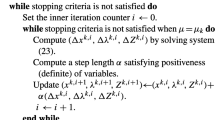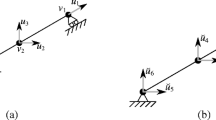Abstract
We consider truss topology optimization problems including a global stability constraint, which guarantees a sufficient elastic stability of the optimal structures. The resulting problem is a nonconvex semi-definite program, for which nonconvex interior point methods are known to show the best performance.
We demonstrate that in the framework of topology optimization, the global stability constraint may behave similarly to stress constraints, that is, that some globally optimal solutions are singular and cannot be approximated from the interior of the design domain. This behaviour, which may be called a global stability singularity phenomenon, prevents convergence of interior point methods towards globally optimal solutions. We propose a simple perturbation strategy, which restores the regularity of the design domain. Further, to each perturbed problem interior point methods can be applied.
Similar content being viewed by others
References
Achtziger, W. 1998: Multiple-load truss topology and sizing optimization: some properties of minimax compliance. J Optim Theory Appl98, 255–280
Ben-Tal, A.; Jarre, F.; Kočvara, M.; Nemirovski, A.; Zowe, J. 2000: Optimal design of trusses under a nonconvex global buckling constraint. Optim Eng1, 189–213
Cheng, G.; Guo, X. 1997: ε-relaxed approach in structural topology optimization. Struct Optim13, 258–266
Cheng, G.; Jiang, Z. 1992: Study on topology optimization with stress constraints. Eng Opt20, 129–148
Cook, R.D. 1974: Concepts and Applications in Finite Element Analysis. New York: Wiley
Duysinx, P.; Bendsøe, M.P. 1998: Topology optimization with stress constraints. Int J Numer Mech Eng43, 1453–1478
Duysinx, P.; Sigmund, O. 1998: New developments in handling stress constraints in optimal material distribution. AIAA, 1501–1509
Evgrafov, A.; Patriksson, M. 2003: Stochastic structural topology optimization: Discretization and penalty function approach. Struct Multidisc Optim25, 174–188
Evgrafov A.; Patriksson, M.; Petersson, J. 2003: Stochastic structural topology optimization: Existence of solutions and sensitivity analyses. ZAMM Z Angew Math Mech83, 479–492
Forsgren, A.; Gill, P.E.; Wright, M.H. 2002: Interior methods for nonlinear optimization. SIAM Rev44, 525–597
Guo, X.; Cheng, G.; Yamazaki, K. 2001: A new approach for the solution of singular optima in truss topology optimization with stress and local buckling constraints. Struct Multidisc Optim22, 364–372
Jarre, F. 2000: An interior method for nonconvex semidefinite programs. Optim Eng1, 347–372
Kirsch, U. 1990: On singular topologies in optimum structural design. Struct Optim2, 133–142
Kočvara, M. 2002: On the modelling and solving of the truss design problem with global stability constraints. Struct Multidisc Optim23, 189–203
Luo, Z.-Q.; Pang, J.-S.; Ralph, D. 1996: Mathematical Programs with Equilibrium Constraints. Cambridge: Cambridge University
Michell, A.G.M. 1904: The limits of economy of material in frame structures. Phil Mag8
Outrata, J; Kočvara, M.; Zowe, J. 1998: Nonsmooth Approach to Optimization Problems with Equilibrium Constraints. Dordrecht: Kluwer Academic
Patriksson, M.; Petersson, J. 2002: Existence and continuity of optimal solutions to some structural topology optimization problems including unilateral constraints and stochastic loads. ZAMM Z Angew Math Mech82, 435–459
Petersson, J. 2001: On continuity of the design-to-state mappings for trusses with variable topology. Int J Eng Sci39, 1119–1141
Rozvany, G.I.N. 1996: Difficulties in truss topology optimization with stress, local buckling and system stability constraints. Struct Multidisc Optim11, 213–217
Rozvany, G.I.N.; Birker, T. 1994: On singular topologies in exact layout optimization. Struct Optim8, 228–235
Sedaghati, R.; Tabarrok, B. 2000: Optimum design of truss structures undergoing large deflections subject to a system stability constraint. Int J Numer Methods Eng48, 421–434
Stolpe, M.; Svanberg, K. 2001: On trajectories of the epsilon-relaxation approach for stress constrained truss topology optimization. Struct Multidisc Optim21, 140–151
Sved, G.; Ginos, Z. 1968: Structural optimization under multiple loading. Int J Mech Sci10, 803–805
Timoshenko, S.P.; Gere, J.M. 1961: Theory of elastic stability. New York: McGraw-Hill
Wolkowicz, H.; Saigal, R.; Vandenberghe, L. (eds.) 2000: Handbook of semidefinite programming, Vol. 27 of International Series in Operations Research & Management Science. Boston: Kluwer Academic
Author information
Authors and Affiliations
Corresponding author
Rights and permissions
About this article
Cite this article
Evgrafov, A. On globally stable singular truss topologies. Struct Multidisc Optim 29, 170–177 (2005). https://doi.org/10.1007/s00158-004-0428-6
Received:
Revised:
Published:
Issue Date:
DOI: https://doi.org/10.1007/s00158-004-0428-6




